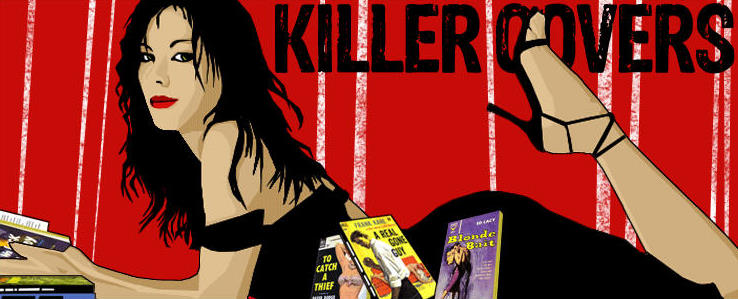

Having finally completed two weeks of work remodeling a room in my house, I can again concentrate on important matters … such as writing about vintage book fronts.
The paperback cover above and on the left comes from the 1959 Midwood edition of Girl of the Streets, by Orrie Hitt, a fairly prolific “sleazecore” novelist of the 1950s and ’60s whose work has enjoyed a good bit of attention over the last few years (see here, here, and here). According to this write-up in a blog devoted to Hitt’s oeuvre, Girl of the Streets is one of the author’s weaker, less original literary efforts. It focuses on young Sherry Collins, a member of an office typing pool, who grew up in the seedier part of her town, “where cheap hookers and booze [are] always available, and shady characters sell reefer and girly pics on the street. But she is a good girl, despite her 38-19-34 figure that all men and boys crave …”
Sherry’s eventual descent into sin is ever swifter and sadder, due to her persistent innocence. Tired of living with her own parents (especially her boozing father), she first moves into “a room rented out by the parents of her boyfriend, Frank,” who seduces her and then promptly cheats on her. (Yeah, who could’ve seen that plot curve coming, right?) Then she relocates to a still more dubious boarding house “that caters to ‘loose’ women who make money in an amoral way consistent with ‘the street,’” only to fall under the libidinous sway of her lesbian-artist roommate. After all of these troubles, you’d think Sherry might be a wee bit more cautious about trusting people. But you’d be wrong. As the previously mentioned blog explains,
[O]ne day she is called into the head man’s office, Freddie Parks. She expects to be canned but instead Mr. Parks tells her he has had his “eye” on her and would like her to represent the company in the local country club beauty pageant.It’s but a small jump from there to Sherry’s debut as a smut photographer’s new model. “This is somewhat a depressing story,” the Hitt blog concludes, as if we couldn’t recognize that already. The best part of the book might be its cover, which was painted by Harry Barton and shows a busty young brunette in a beret, who might be cocking her shapely hip on a street in Paris … though it’s obvious that this “nice girl on her way down” (to quote from the cover lines) will be lucky to make it to her 40th birthday, much less Europe.
She is flattered, floored, and naïve to boot—others try to warn her, and she soon figures out that these beauty contests are rigged and just a way for old married businessmen to flirt and sleep with pretty young girls. Freddie has rigged the contest so the judges will vote for her—this is after he beds Sherry. She is naïve enough to think that dinner and drinks with her married boss is nothing serious—she holds up her guard until he tells her sweet nothings and how he will leave his wife and marry her. He even makes her his personal secretary, [Sherry] not knowing that there have been three other secretaries, all whom he impregnated.
You might not guess that our second book under consideration this week, Richard Foster’s The Girl from Easy Street (shown above, right), is also about a young miss gone wrong. The artwork decorating this 1960 Popular Library edition of the novel, credited to Robert McGinnis, makes it look like a lighthearted tale of a woman negotiating the travails of laboring in a modern office. But the teaser text fronting the original, 1955 edition of Foster’s book hints at very different doings. “The tragic story of a teen-age girl who wanted
 too much too soon, and ran the
brutal gamut of delinquency,” reads that cover copy, while the back offers this synopsis:
too much too soon, and ran the
brutal gamut of delinquency,” reads that cover copy, while the back offers this synopsis:
Betty Jane Allen was a pretty high school girl, who scandalized a small town …By the way, “Richard Foster” was another of several pseudonyms employed by New Yorker Kendell Foster Crossen (1910-1981), who also concocted private-eye fiction as “M.E. Chaber.” You’ll find another of his Foster novels showcased here.
Betty Hamill was a hoodlum’s moll, looking for thrills and a fast dollar …
Mrs. Chalice was in business and her phone number was for men only …
Mrs. Lance Peru was a Park Avenue beauty, available to the Vice Syndicate’s murder squad …
But they were all the same girl. A girl looking for Easy Street, but lost on a one-way road to ruin.







